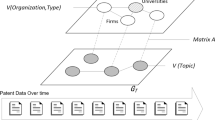Abstract
The aim of the paper is to show how the transition from the emergence of a technology to its development phase impacts the evolution of the structure of the collaboration network. In order to identify these first phases of the life cycle of the technology a method is developed based on the International Patent Classification. Using this method, we identify when a technology transitions from an emerging technology to a stage in which applications of the technology are found. We then compare the moment at which this transition occurs to the evolution of the collaboration network for the same technology and show that there is a significant change in the structure of the network when this transition occurs.








Similar content being viewed by others
Notes
The ability of firms to absorb and send knowledge also plays an important role.
References
Abercrombie, R. K., & Loebl, A. S. (2014). Systems life cycle and its relation with the triple helix. Measuring scholarly impact (pp. 103–125). Springer International Publishing.
Abercrombie, R. K., Schlicher, B. G., & Sheldon, F. T. (2015). Scientometric methods for identifying emerging technologies. U.S. Patent No 9,177,249.
Abercrombie, R. K., Udoeyop, A. W., & Schlicher, B. G. (2012). A study of scientometric methods to identify emerging technologies via modeling of milestones. Scientometrics, 91(2), 327–342.
Ahuja, G. (2000). Collaboration networks, structural holes, and innovation: A longitudinal study. Administrative Science Quarterly, 45(3), 425–455.
Alencar, M., Porter, A., & Antunes, A. (2007). Nanopatenting patterns in relation to product life cycle. Technological Forecasting and Social Change, 74(9), 1661–1680.
Barabási, A.-L., & Albert, R. (1999). Emergence of scaling in random networks. Science, 286(5439), 509–512.
Buchmann, T., & Pyka, A. (2013). The evolution of innovation networks: The case of a German automotive network. In FZID Discussion Papers.
Gao, L., Porter, A. L., Wang, J., Fang, S., Zhang, X., Ma, T., et al. (2013). Technology life cycle analysis method based on patent documents. Technological Forecasting and Social Change, 80(3), 398–407.
Gulati, R., Sytch, M., & Tatarynowicz, A. (2012). The rise and fall of small worlds: Exploring the dynamics of social structure. Organization Science, 23(2), 449–471.
McEvily, B., & Marcus, A. (2005). Embedded ties and the acquisition of competitive capabilities. Strategic Management Journal, 26(11), 1033–1055.
McKelvey, M., Alm, H., & Riccaboni, M. (2003). Does co-location matter for formal knowledge collaboration in the Swedish biotechnology–pharmaceutical sector? Research Policy, 32(3), 483–501.
Owen-Smith, J., & Powell, W. W. (2004). Knowledge networks as channels and conduits: The effects of spillovers in the Boston biotechnology community. Organization Science, 15(1), 5–21.
Rosenkopf, L., & Schilling, M. A. (2007). Comparing alliance network structure across industries: Observations and explanations. Strategic Entrepreneurship Journal, 1(3–4), 191–209.
Salavisa, I., Sousa, C., & Fontes, M. (2012). Topologies of innovation networks in knowledge-intensive sectors: Sectoral differences in the access to knowledge and complementary assets through formal and informal ties. Technovation, 32(6), 380–399.
Saviotti, P. P. (2007). On the dynamics of generation and utilisation of knowledge: The local character of knowledge. Structural Change and Economic Dynamics, 18, 387–408.
Shan, W., Walker, G., & Kogut, B. (1994). Interfirm cooperation and startup innovation in the biotechnology industry. Strategic Management Journal, 15(5), 387–394.
Stolwijk, C., Ortt, J., & den Hartigh, E. (2013). The joint evolution of alliance networks and technology: A survey of the empirical literature. Technological Forecasting and Social Change, 80(7), 1287–1305.
Szulanski, G. (1996). Exploring internal stickiness: imepdiments to the transfer of best practise within the firm. Strategic Management Journal, 17(Special issue), 27–43.
Tomasello, M. V., Napoletano, M., Garas, A., & Schweitzer, F. (2013). The rise and fall of R&D networks. ArXiv Preprint ArXiv:1304.3623.
Trappey, C. V., Wang, T.-M., Hoang, S., & Trappey, A. J. (2013). Constructing a dental implant ontology for domain specific clustering and life span analysis. Advanced Engineering Informatics, 27(3), 346–357.
Tsai, W. (2001). Knowledge transfer in intraorganizational networks: Effects of network position and absorptive capacity on business unit innovation and performance. Academy of Management Journal, 44(5), 996–1004.
Uzzi, B., & Spiro, J. (2005). Collaboration and creativity: The small world problem 1. American Journal of Sociology, 111(2), 447–504.
Van Der Pol, J. (2015). Structural dynamics of the French aerospace sector: A network analysis. In Working Papers Hal-01284993, HAL.
van der Valk, T., Chappin, M. H., & Gijsbers, G. W. (2011). Evaluating innovation networks in emerging technologies. Technological Forecasting and Social Change, 78, 25–39.
Verspagen, B., & Duysters, G. (2004). The small worlds of strategic technology alliances. Technovation, 24(7), 563–571.
Virapin, D., & Flamand, M. (2013). L’innovation dans les matériaux composites, quelle diffusion autour de quels acteurs?. In Presented at the P2i conference 2013.
Watson, J. (2007). Modeling the relationship between networking and firm performance. Journal of Business Venturing, 22(6), 852–874.
Watts, D. J., & Strogatz, S. H. (1998). Collective dynamics of ‘small-world’ networks. Nature, 393(4), 440–442.
Acknowledgements
The authors are grateful for the financial support from l’Initiative d’Excellence of the University of Bordeaux, the Regional Council of New Aquitaine and the ITEMM Lab financed by Michelin. Comments and suggestions from Murat Yildizoglu, Francesco Lissoni, Bart Verspagen, Thomas Vallée, Andreas Pyka and anonymous referees are gratefully appreciated.
Author information
Authors and Affiliations
Corresponding author
Rights and permissions
About this article
Cite this article
van der Pol, J., Rameshkoumar, JP. The co-evolution of knowledge and collaboration networks: the role of the technology life-cycle. Scientometrics 114, 307–323 (2018). https://doi.org/10.1007/s11192-017-2579-4
Received:
Published:
Issue Date:
DOI: https://doi.org/10.1007/s11192-017-2579-4
Keywords
- Innovation
- Technology life cycle
- Patents analysis
- Publications
- Network analysis
- Scale-free network
- Structure Composite Materials




